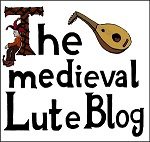The data below contains medieval lute tablature, most of them are suitable for medieval five-course lute in a G-tuning. Please keep in mind, that the use of the low D-string as a drone tone is somewhat optional when working with the 5-course versions. However, the songs marked with a 4c! are written for the medieval four-course lute in a G-tuning.
In general, the tablature is structured into Medieval songs based on authentic melodies, Medieval songs with unclear authenticity of melody and Modern interpretations based on medieval lyrics. The latter are mainly based on authentic medieval lyrics (e.g. the Carmina Burana), the melodies of which were reconstructed in the 19th century during the Romantic era by composers like Carl Orff and others.
Within these categories, you will also find the distinction between “Secular music” and “Sacral music“, although this might historically not have been carried out consistently, such as in the Llibre Vermell de Montserrat.
Furthermore, the tablature is devided into different levels of complexity, such as Short and simple pieces, Intermediate pieces and Advanced pieces. You will also find a small selection of Medieval dances and other forms of music.
Please keep in mind that the tablature presented on this Blog almost completely depicts the cantus, meaning the main theme or melody of any given piece! An exception is the the segment “Advanced pieces” in which both, the cantus as well as the discantus can sometimes be depicted in one piece!
Again, this Blog does not neccessarily show the historic reality of “medieval music” or “medieval lute music” as it was actually performed in any given century, for the simple reason that we don`t know exactly how the themes were being played and arranged, etc.! This is merely an attempt at approximation.
Medieval songs based on authentic melodies
Secular music
Short and simple pieces (Cantus)
Intermediate pieces (Cantus)
Trouvères, Troubadours & Minstrels
Advanced pieces (Cantus & Discantus)
Medieval dances (Cantus)
Sacral music (Cantus)
Cantigas de Santa Maria (Alfonso X “el sabio”)
Llibre Vermell de Montserrat
Other medieval sacral music (Cantus)
Early Renaissance (Cantus & Discantus)
Medieval songs with unclear authenticity of melody
Secular music
Medieval Jewish heritage (Cantus)
Trouvères, Troubadours & Minstrels (Cantus)
Dances (Cantus)
Renaissance (Cantus & Discantus)
Modern interpretations based on medieval lyrics
Secular music
Short and simple pieces (Cantus)
Carmina burana/Codex buranum
Intermediate pieces (Cantus)
Codex Manesse
Trouvères, Troubadours & Minstrels
Advanced pieces (Cantus & Discantus)
Medieval dances (Cantus)
Carmina burana/Codex buranum
Other dances
Non-medieval folk songs (Origin unclear)
Ballads
Dances
Modern songs based on historicization
Marches
Dances
Hint: If you play a four-course medieval lute (or any other instrument like e.g. a citole or a medieval gittern) that is tuned in /D/ /A/ /d/ /g’/, you can also play all the 5-course pieces in the list by using the 5th fret on the low D-string in order to substitute the low /G/-string. Many pieces do not require the low G-string or tone at all, but will use the open low D-string more frequently.
